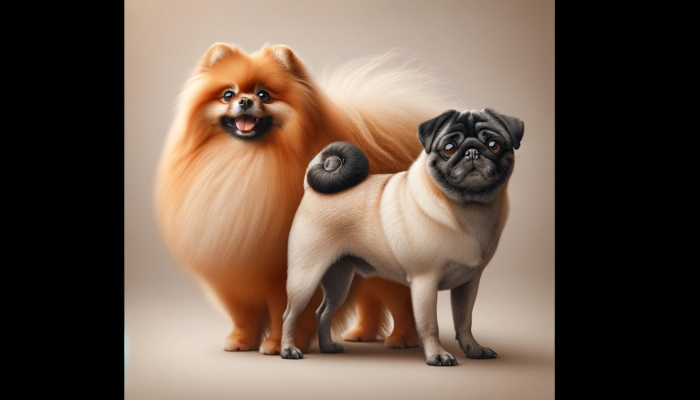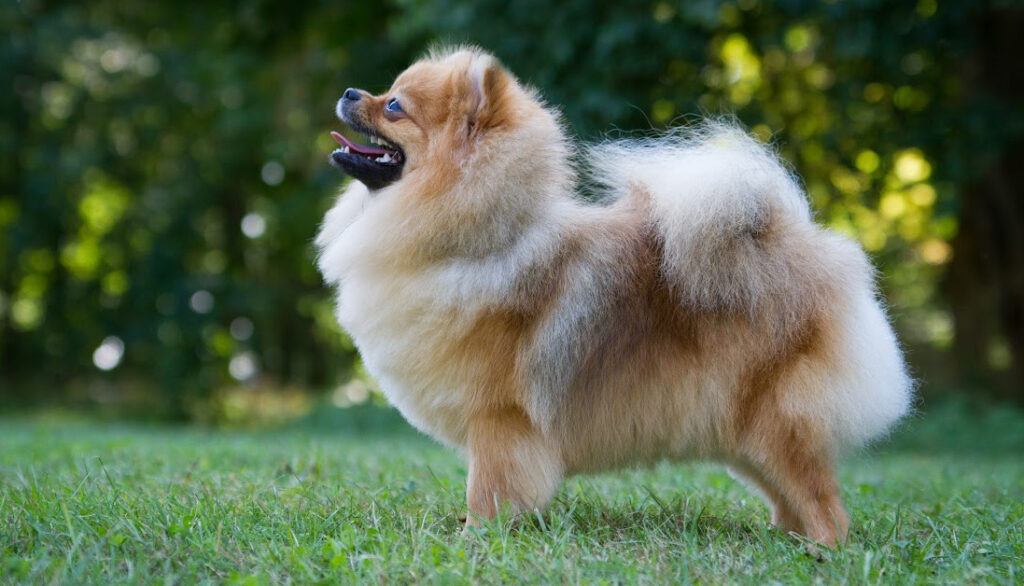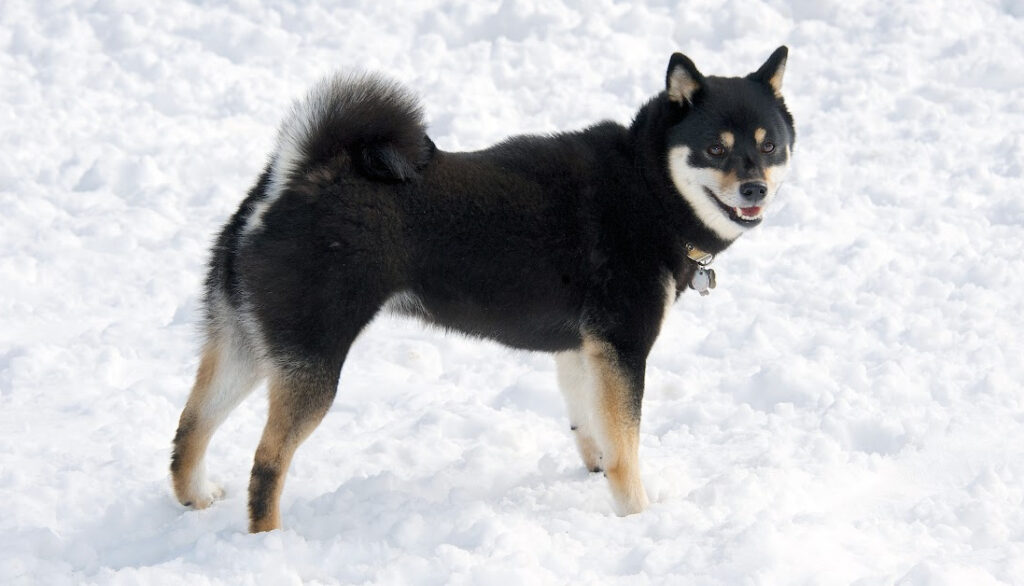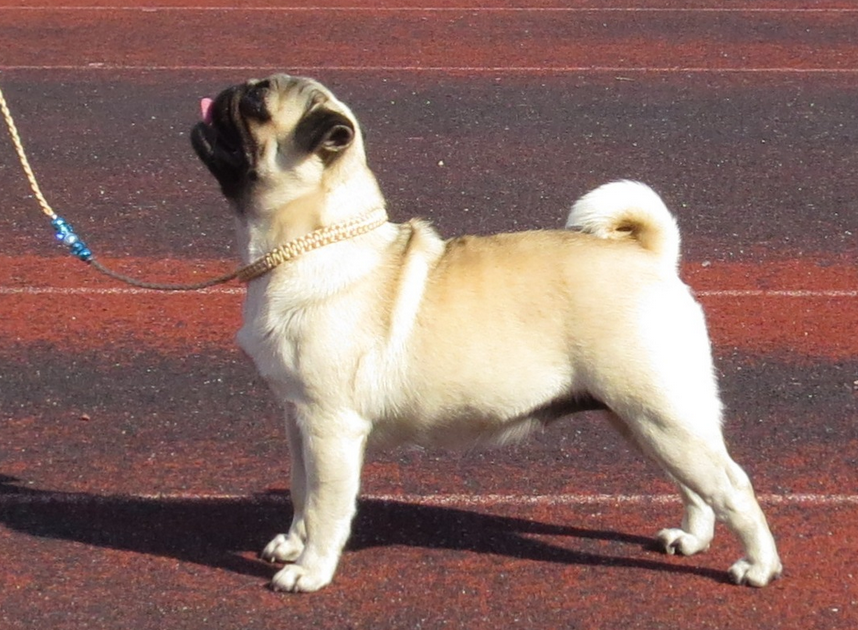Dog breeds with curled tails are a sight to behold. These spiraled wonders have surely caught your attention at a local park or even a dog show. But have you ever stopped to wonder what’s behind the genetic marvel of these captivating curls? Or why some breeds carry their tails high and curled over their backs while others don’t?

Genetically speaking, tail curl among canine breeds is predominantly a result of selective breeding. Our ancestors selected specific traits that they found appealing or beneficial, leading to the development of a variety of breeds with curled tails. The curling of a dog’s tail can serve practical purposes as well. For instance, the huskies and malamutes of the Arctic regions use their bushy, curled tails to cover their noses while sleeping, providing warmth in harsh, cold conditions.
Now, let’s delve into some of the many breeds that boast this unique tail trait. From spitz-type breeds, like the fluffy Pomeranian with its majestic curled tail, to non-spitz breeds such as the Basenji, famously known as the “barkless breed” with a tight curl. Or, consider the Shiba Inu, a compact breed with a prominent curl, and the Akita, a larger breed known for its luxurious curled tail. Each breed carries a rich history interwoven with the unique tail trait.

The Evolutionary Purpose of Curled Tails in Dogs
Ever wondered why certain dog breeds come equipped with elegantly curled tails? Well, it’s more than just a fancy addition to their physique. The curled tail has deep roots in a dog’s evolutionary past, serving essential functions that might surprise you.
Tail Curling for Warmth and Communication
As you snuggle up in your cozy blanket on a chilly winter’s night, imagine our canine friends in the wild. For them, the curled tail acts as a natural comforter, wrapping around the body to keep them warm in cold weather. Who wouldn’t love a built-in fur scarf?
The spiraled tail also holds a crucial role in dog communication. Tail carriage and movement, including its curl, can signal a variety of emotions and intentions. A high and tightly curled tail often signifies alertness or excitement, while a more relaxed curl can indicate a relaxed demeanor. It’s like a secret language that we, as humans, are privileged enough to decode.
The Role of Curled Tails in Dog Breeding and Selection
In the world of dog breeding, a curled tail isn’t just a cute quirk—it’s a vital trait that defines the breed standard for many of our favorite dog breeds with curled tails like the cheerful Pomeranian or the dignified Akita.
These distinguishing features have been selected and bred over generations, contributing to the breed’s unique identity. It’s a blend of fascinating genetics and the aesthetic preferences of breeders and dog lovers alike.
For instance, take the Pug, one of the most popular breeds known for their tightly curled tail. This characteristic, along with their adorable wrinkled face, has been intentionally maintained by breeders over centuries, making Pugs instantly recognizable.
Similarly, the majestic curl of the Akita’s tail tells a tale of their Japanese lineage, where a curled tail was seen as a symbol of good luck. These tails are not just stunning to behold, but they carry a piece of the breed’s history and cultural significance.
| Breed | Significance of Curled Tail |
|---|---|
| Pug | Instantly recognizable feature, loved for its aesthetic appeal |
| Akita | A symbol of good luck in their native Japan |
But it’s not all about looks. The curl of a dog’s tail can also provide insights into their health. For example, an uncharacteristically limp tail in a breed known for their curl can signal a health issue, making the tail a handy barometer for a dog’s wellbeing.
Spitz-Type Breeds with Characteristic Curled Tails
Spitz-type breeds are typically the first dogs that come to mind when thinking about breeds with curled tails. Originating from cold climates, these dogs have thick double-coats, erect ears, and of course, curled tails. They were historically used for sledding, hunting, and companionship in harsh wintry conditions. Here are some notable Spitz breeds:
– Alaskan Malamute: Known for their strength and endurance, the Alaskan Malamute has a plume-like curled tail that lays over their back.
– American Eskimo: Despite its name, the American Eskimo dog originates from Germany. This breed has a fluffy tail that curls over its back.
– Siberian Husky: Famously used for sled pulling, the Siberian Husky has a bushy tail that curls up and over their back.
– Chow Chow: This ancient Chinese breed has a unique bluish-black tongue and a tail that curls tightly over its back.
– Samoyed: The Samoyed’s tail curls up and over their back, but with a unique twist; it usually rests on the side, not the center of their back.
Non-Spitz Breeds Featuring the Curled Tail Trait
While Spitz breeds are most commonly associated with curled tails, there are other breeds outside this group that also boast this charming feature. Here are a few of them:
– Pug: The Pug’s tail is one of its most distinct features. It curls up tightly over the hip, often forming a double curl.
– Shih Tzu: This little breed often has a tail that curls over its back. However, the curl might not be as tight as those found in Spitz breeds or Pugs.
– Basset Hound: Known for their droopy ears and somber expressions, Basset Hounds also have a slightly curled tail, which is usually carried high.
– Basenji: Also known as the barkless dog, the Basenji has a tightly curled tail that sits on one side of its rump.
– Affenpinscher: This small, terrier-like breed has a tail that is typically docked to a short length and carried high in a gentle curve.
These are just a few of the many dog breeds with curled tails. When choosing a breed, consider not just the aesthetics of the tail, but also the breed’s temperament, care needs, and suitability to your lifestyle. Each of these breeds, with their unique spiraled tails, brings something special to the table—whether it’s the hardworking Siberian Husky, the loving Pug, or the independent Basenji. Just remember, the tail is just one part of your future pet’s makeup, but it certainly does add to their charm!
The Pomeranian: A Toy Breed with a Majestic Curled Tail
Known for its fox-like face and plush coat, the Pomeranian is one of the most recognizable dog breeds with curled tails. As a toy breed, it is small in stature but large in character. The Pomeranian’s tail, which arches over the back in a spiral, is one of the breed’s most distinctive features.
Understanding the Pomeranian’s Tail Curl
The Pomeranian’s tail curl is a result of specific genetic traits. It curves over its back and lies flat, creating a ‘fan’ of fur known as a plume. This tail curl isn’t just for show, though. It serves an important purpose. It acts as a warmth provider in cold weather, similar to other Spitz breeds. When a Pomeranian curls up to sleep, its tail acts like a cozy blanket, covering its nose and feet.
The Pomeranian’s Popularity and Spiraled Tail Standard
Pomeranians have always been popular for their personality and looks, but their curled tail certainly adds to their charm. In fact, breed standards strictly require this feature. According to the American Kennel Club, a Pomeranian’s tail should be “high set, tightly curled over the back and should lie flat and straight on the back, not flat or crinkled.”
This tail standard is not just about aesthetics; it’s also about health. A Pomeranian with a tail that doesn’t curl properly could indicate underlying health issues, such as spinal problems or genetic defects. Therefore, maintaining the curled tail standard is crucial for the breed’s overall health and integrity.
Despite being small in size, Pomeranians command attention wherever they go. Their fluffy coats and spiraled tails make them standout, often leading to their success in dog shows. Dog enthusiasts often refer to the Pomeranian’s tail as a sign of its spirited character and spunk.
Adopting a Pomeranian means having a spirited, fluffy companion with a distinctive tail curl. Their tails not only add to their physical appeal but also serve a practical function, further emphasizing the unique allure of dog breeds with curled tails. As a prospective Pomeranian parent, it’s crucial to remember that their majestic curl comes with a responsibility for regular grooming and health checks. After all, maintaining their iconic spiraled splendor also means ensuring their overall well-being.

The Basenji: The Barkless Breed with a Tight Curl
Among the unique dog breeds with curled tails, the Basenji holds a special place. Known as the ‘barkless dog,’ this breed boasts a tightly curled tail that adds to its distinctive appearance.
The Unique Tail Curl of the Basenji
The Basenji’s tail is not just curled; it’s tightly coiled, resting over one hip in a neat spiral. This is one of the breed’s most recognizable features, setting it apart from other curly tailed dog breeds. The tail’s tight curl is a genetic trait, passed down through generations of Basenjis.
Unlike some other breeds, where the tail may uncurl when the dog is relaxed, the Basenji’s tail remains curled at all times. This gives the breed a poised, alert look, even when at rest. The tail’s curl is so tight that it often forms a double curl, looping around to touch the dog’s back.
The Basenji’s African Heritage and Tail Significance
The Basenji’s heritage can be traced back to central Africa, where it was used for hunting. The breed’s curled tail was not just for show; it served a practical purpose as well. The tight curl made the tail highly visible in tall grass, allowing hunters to keep track of their dogs during a chase.
The Basenji’s tail is also an important part of its communication. Like other dogs, Basenjis use their tails to express their emotions. A wagging tail usually indicates excitement or happiness, while a still tail can signal that the dog is focused or alert.
The Basenji’s African roots have also influenced its physical characteristics, including its distinctive tail. The breed’s ancestors needed to survive in a hot climate, and a short, curly tail helped to dissipate heat. This is another example of how the Basenji’s unique tail has been shaped by both its genetic heritage and its environmental adaptations.
In addition to its practical functions, the Basenji’s tail is also a key element of the breed’s standard. Breeders and judges look for a tight curl, with the tail carried over the hip. The tail’s shape and position can affect a Basenji’s success in the show ring, demonstrating how this physical trait has become an integral part of the breed’s identity.
In conclusion, the Basenji’s tightly curled tail is not just a charming feature; it’s a testament to the breed’s rich history and adaptability. Whether you’re a dog lover, a prospective pet owner, or a seasoned breeder, the Basenji’s distinctive tail is sure to capture your attention and your heart.
The Shiba Inu: A Small Breed with a Big Curl
The Shiba Inu, a Japanese breed known for their bold spirit and good nature, has one of the most recognizable tails among dog breeds with curled tails. Their curl is not just visually appealing, but it also has deep-rooted cultural significance.
The Cultural Significance of the Shiba Inu’s Tail
The Shiba Inu’s tail is one of its defining features, often curling over the back in a tight spiral. In Japan, where the breed originated, the tail’s curl is considered a sign of good luck. This belief is deeply ingrained in Japanese culture, and Shiba Inus are often depicted in traditional Japanese art and folklore.
The Shiba’s tail is also highly prized in the show ring, with judges often looking for a tight curl that can rest on the dog’s back. The curl’s shape and position are essential to the breed’s overall appearance and contribute significantly to a Shiba Inu’s unique charm and elegance.
Physical and Behavioral Traits Linked to the Shiba Inu’s Curled Tail
Apart from cultural significance, the Shiba Inu’s curled tail is also linked to the breed’s distinctive physical and behavioral traits.
Physically, Shiba Inus are compact, muscular dogs, with a thick double coat that adds extra volume to their tail’s curl. Their tails are strong and flexible, allowing them to express their mood or communicate with other dogs. When a Shiba Inu is relaxed, their tail may uncoil slightly, while it tightens when they’re alert or excited.
Behaviorally, Shiba Inus are known for their spirited and independent nature. They’re often described as “cat-like” due to their clean habits, agility, and the way they use their tail to communicate. Additionally, like a cat’s tail, a Shiba Inu’s curled tail can give you a good indication of their mood. For example, if the tail uncurls and drops, it may indicate that the dog is anxious or uncomfortable.
In terms of health, the Shiba Inu’s tail is usually robust and not prone to specific health issues. However, regular grooming is essential to maintain the health of their double coat and prevent any potential skin issues underneath the tail.
If you’re a proud parent of a Shiba Inu or considering adopting one, remember to take the time to admire and care for their special curled tail. It’s part of what makes this breed unique, encapsulating both their cultural heritage and spirited personality. No wonder it’s one of the most admired dog breeds with curled tails.

The Akita: A Large Breed with a Luxurious Curled Tail
The Akita, a large and majestic breed, is well-known for its powerful stature and striking curled tail. Originating from Japan, Akitas are one of the most recognizable dog breeds with curled tails.
The Akita’s Tail Curl as a Breed Hallmark
The Akita’s tail has a strong curl that rests over the dog’s back or flank, creating a beautiful symmetry with its robust body. This breed’s tail curl is unique, often described as a double curl or a loose curl. This characteristic is so central to the breed’s identity that a well-curled tail is considered an essential feature for this breed, especially in dog shows.
The curl of an Akita’s tail is not just for show, either. It’s a genetic trait that has been carefully preserved over centuries of breeding. Not all Akitas have the same type of curl – it can vary from a gentle curve to a tight spiral. Despite these variations, the curl always adds a touch of elegance and distinctive beauty to this magnificent breed.
The Historical and Cultural Importance of the Akita’s Tail
The Akita’s curled tail doesn’t just make it a standout in the ring; it also carries historical and cultural significance. In Japan, Akitas hold a special place in society. They are considered a national treasure and a symbol of good health, happiness, and longevity. Their thick, curled tails are seen as a symbol of strength and energy, reflecting the breed’s noble and resilient nature.
The Akita’s tail has deep-rooted cultural ties, and it’s a common subject in many ancient Japanese artworks and sculptures, representing the breed’s prestige and respect in society. Moreover, the Akita’s tail is considered a key aspect of the breed’s character, conveying its alertness and spirited personality.
Akitas were originally bred for hunting large game, such as bears, boars, and deer. The breed’s strong curled tail served as a visible signal for hunters in the field, making them easy to spot even at a distance. This once practical aspect of the Akita’s tail has now become a defining aesthetic feature, contributing to the breed’s unique charm and allure.
It’s important to note that while the Akita’s curled tail is a defining characteristic, the breed is much more than just its tail. Akitas are known for their loyalty, intelligence, and courage, making them wonderful companions for those who understand and appreciate their independent and protective nature.
When considering adding an Akita to your family, remember that while their luxurious curled tails may be a captivating feature, it’s their heart and spirit that truly set them apart. As with all dog breeds with curled tails, owning an Akita requires understanding, patience, and a whole lot of love. After all, the beauty of these breeds is not just in their distinct physical features, but in their unique personalities and rich histories.
Caring for Curled Tail Dog Breeds
Grooming Needs for Curled Tails
The first thing to note when caring for dog breeds with curled tails is their grooming needs. These canines, with their spiraled splendor, require a bit more attention when it comes to tail maintenance.
- Curled tails can be a magnet for dirt and debris, especially in breeds with longer hair such as the Pomeranian or Akita. Regular brushing of the tail is necessary to keep it clean and free from tangles.
- Some breeds, like the Shiba Inu, have a thick double coat. They’ll require periodic grooming sessions to ensure their tail is free from any matting.
- Although rare, sometimes the hair on the tail can grow too long and cause discomfort. In such cases, a trim may be needed.
Remember that grooming is not just a chore; it’s also a bonding time with your furry friend. So make sure to be gentle and patient, especially when dealing with their sensitive tail area.
Health Considerations Specific to Curled Tail Breeds
While the curled tail is a charming trait, it comes with its own set of health considerations.
- Spinal issues: Certain breeds with curled tails, such as the Pug, are more prone to spinal problems due to the same genetic factors that influence tail curling. Regular vet check-ups are essential to catch any potential issues early.
- Tail injuries: A curled tail can be more susceptible to injuries, especially if your pup is particularly active or playful. Keep an eye out for any signs of discomfort or pain.
- Skin problems: The area beneath the curl of the tail can sometimes be a hotspot for skin issues, including infections and parasites. Regular cleaning and grooming can help prevent these problems.
It’s important to remember that every dog is an individual, and not every canine with a curled tail will face these issues. However, knowing what to look out for can ensure your pup stays as healthy and comfortable as possible.
Wrapping Up
Whether your furry friend is a compact Shiba Inu, a noble Akita, a toy-like Pomeranian, or a unique Basenji, knowing how to care for their distinct curled tail is crucial. These spiraled marvels require special grooming attention to stay clean and tangle-free, and keeping an eye out for potential health issues can ensure your canine companion leads a comfortable, happy life.
Remember, their curled tail isn’t just a cute aesthetic feature, but also a part of their heritage and individuality. So, take the time to understand the needs of your pet’s curled tail – it’s a small price to pay for the joy and companionship these unique pups bring to our lives.
Frequently Asked Questions
Q1: What are some dog breeds with curled tails?
A: Some dog breeds with curled tails include the Alaskan Malamute, Pomeranian, Shiba Inu, and the Norwegian Elkhound.
Q2: Does a curled tail indicate any specific breed traits?
A: While a curled tail can be a distinctive feature of certain breeds, it doesn’t necessarily indicate any specific breed traits. It’s more of a physical characteristic than a behavioral one.
Q3: Can a dog’s tail change from straight to curled as they grow?
A: In most cases, a dog’s tail will not change from straight to curled as they grow. The shape of a dog’s tail is determined by their genetics and is usually set by the time they are born.
Q4: Does a curled tail affect a dog’s health in any way?
A: Generally, a curled tail does not affect a dog’s health. However, in some cases, a tightly curled tail can be associated with certain spinal issues. It’s always best to consult with a vet if you have any concerns.
Q5: Can a dog with a straight tail have puppies with curled tails?
A: Yes, a dog with a straight tail can have puppies with curled tails if they carry the gene for it and mate with a dog that also carries the gene.
Dr. Candy, a holistic veterinarian and certified raw dog food nutrition specialist, graduated from Oklahoma State University in 2009 with a DVM and has since specialized in companion animal nutrition, advocating for species-specific diets. With a background in wildlife rehabilitation and oil spill response, she combines holistic health and conventional medicine in her unique approach to treating chronic diseases, allergies, and autoimmune conditions in pets. As the owner of a veterinary practice in Colorado and an author, Dr. Candy is dedicated to educating pet parents and improving the health and happiness of animals.




